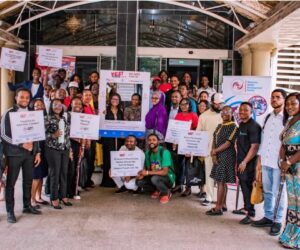6
The Federal Government has announced plans to review the retirement age of Air Traffic Controllers (ATCOs) in Nigeria as part of efforts to address the persistent manpower gap and enhance safety and efficiency within the nation’s airspace management system.
Minister of Aviation and Aerospace Development, Mr Festus Keyamo (SAN), made the disclosure on Tuesday while declaring open the 54th Annual General Meeting and Conference of the Nigerian Air Traffic Controllers’ Association (NATCA), held at the Nigerian Air Force (NAF) Conference Centre, Abuja.
The two-day conference has as its theme: “The Human Edge: Capacity Building in the Next Generation Air Traffic Management.”
Mr Keyamo said the Ministry would work closely with relevant authorities to review the retirement age upward, allowing experienced controllers to continue contributing to the sector while mentoring younger professionals.
“I listened to the President’s speech on the age of retirement of Air Traffic Controllers, and I think I am convinced it is something I can take up,” the Minister said. “If pilots can fly at the age of 65 years, there is no reason why Air Traffic Controllers cannot also serve until 65.”
He described NATCA as “the apple of the eye of aviation”, assuring the Association of the Federal Government’s continued support in enhancing safety and efficiency in Nigeria’s skies.
“The Air Traffic Controllers are in charge of the safety of the skies. We will give them the support they need to function effectively,” Keyamo stated.

He further noted that Nigeria was currently short of Air Traffic Controllers and emphasised the need to bridge the gap to sustain the growing demands of the aviation industry.
In his welcome address, Mr Edino Ilemona Amos, President of NATCA, expressed appreciation to the Minister for his commitment and urged the Federal Government to expedite the review of the retirement age from 60 to 65 years.
He warned that without decisive intervention, the nation could face a severe shortage of Air Traffic Controllers by 2030.
“Current projections indicate that if decisive measures are not taken, by 2030, despite the expected growth in national aviation activities, the Air Traffic Controller workforce could decline sharply, potentially widening the manpower gap by up to 70%,” Amos cautioned.
He explained that the challenges were exacerbated by “a wave of retirements, the migration of skilled professionals abroad (the ‘Japa’ trend), and inter-agency transfers driven by the search for better opportunities.”
Highlighting the Association’s achievements in the past year, Amos reported that over 150 controllers had received international training in Performance-Based Navigation (PBN), Controller–Pilot Data Link Communications (CPDLC), On-the-Job Training Instruction (OJTI), Unmanned Aircraft (UA) Fundamentals, and UTM Airspace Integration, as well as Search and Rescue Operations.
Additionally, over 300 controllers benefited from domestic training programmes initiated by the Nigerian Airspace Management Agency (NAMA), while NATCA also hosted webinars on Team Resource Management, Safety Scenario Analysis, and Mental Well-being.
He also announced that, following sustained advocacy, the long-awaited salary adjustment for Air Traffic Controllers in NAMA was signed in August 2025 and implemented in September, describing it as a “landmark achievement”.
“This achievement should, in due course, be extended to other agencies housing Air Traffic Controllers, ensuring equity and uniform recognition of our professional value across the aviation sector,” he said.

Amos further disclosed that NAMA, through the Directorate of Air Traffic Services (DATS), had commenced the distribution of secured warm clothing to Air Traffic Controllers working in low-temperature environments across major stations nationwide.
Mr Amos also recounted a series of landmark milestones achieved under his leadership. Among these was Nigeria’s election into four IFATCA Standing Committees—a historic first that positioned the country as an active voice in international air traffic management.
In April 2025, NATCA hosted the IFATCA Africa and Middle East Executive Council Meeting in Abuja – the first of its kind in Nigeria – and signed a Memorandum of Understanding (MoU) with United ATS on 29 May 2025, which led to the first-ever NATCA workshop taking place during this AGM.
Additionally, the Association launched the Sky Bridge Foundation, a mentorship initiative designed to inspire and train the next generation of aviation professionals in Nigeria.
Despite the strides, Amos acknowledged that the sector still faces significant hurdles, including CNS/ATM infrastructure deficits estimated at 68%, and incomplete Conditions of Service (COS) negotiations.
He called for an urgent review and upward adjustment of the retirement age to 65 years, aligning with international standards and other critical professions, to preserve institutional knowledge and sustain operational efficiency.
Quoting Sir Winston Churchill, he said: “It is not enough that we do our best; sometimes we must do what is required. What is required of us today is persistence, partnership, and purpose-driven leadership.”
Responding to the concerns raised by NATCA, Minister Keyamo reiterated the government’s commitment to addressing manpower shortages and improving working conditions for Air Traffic Controllers.
“I will sit with the Permanent Secretary to carefully study this proposal and ensure that we secure approval for the upward review,” he assured.
He emphasised that Air Traffic Controllers play a vital role in ensuring aviation safety, adding that retaining experienced hands would not only bridge the skill gap but also improve operational stability across the country’s airspace network.
In his closing remarks, Amos expressed optimism about the future of Nigerian aviation, stating that while technology continues to evolve, human expertise remains indispensable.
“Automation and artificial intelligence may be reshaping aviation, but human intellect, intuition, and judgement remain the ultimate safeguards of safety and efficiency,” he said.
He noted that in 2024, Nigerian Air Traffic Controllers managed over 420,000 aircraft movements, a 12% increase from the previous year, despite operating with less than 65% of the required manpower.
“Every safe landing and every smooth departure bears the unseen signature of an Air Traffic Controller. This is proof that excellence and dedication define who we are,” Amos added.
He concluded by reaffirming NATCA’s commitment to unity, progress, and capacity development, ensuring that Nigeria remains a leading force in African aviation.
The 54th NATCA AGM continues in Abuja with technical sessions, workshops, and discussions centred on innovation, safety enhancement, and human capital development for next-generation air traffic management.








